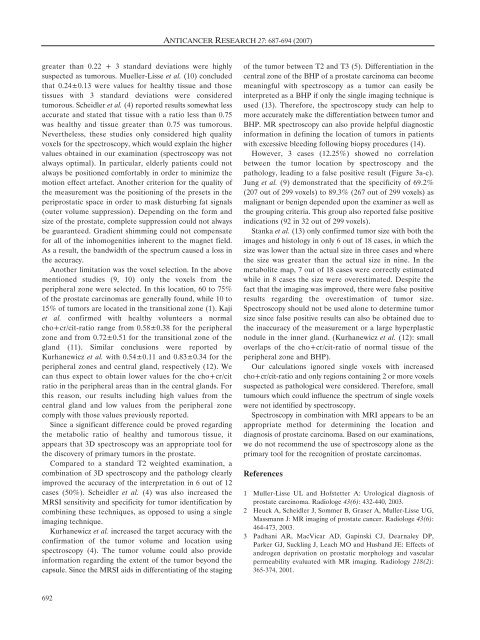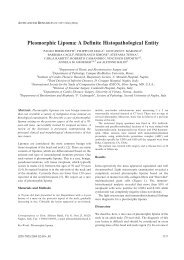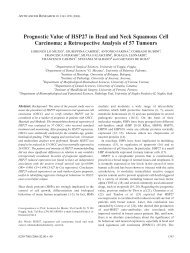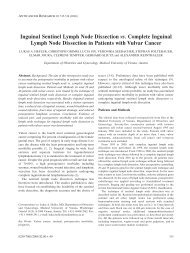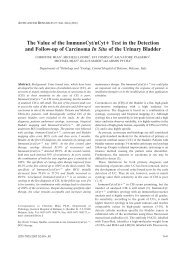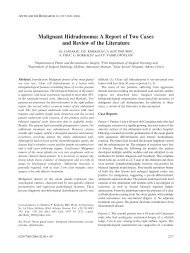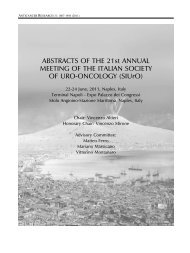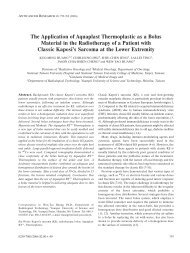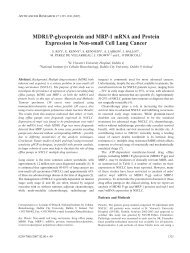MRI Spectroscopy in Screening of Prostate Cancer - Anticancer ...
MRI Spectroscopy in Screening of Prostate Cancer - Anticancer ...
MRI Spectroscopy in Screening of Prostate Cancer - Anticancer ...
You also want an ePaper? Increase the reach of your titles
YUMPU automatically turns print PDFs into web optimized ePapers that Google loves.
greater than 0.22 + 3 standard deviations were highly<br />
suspected as tumorous. Mueller-Lisse et al. (10) concluded<br />
that 0.24±0.13 were values for healthy tissue and those<br />
tissues with 3 standard deviations were considered<br />
tumorous. Scheidler et al. (4) reported results somewhat less<br />
accurate and stated that tissue with a ratio less than 0.75<br />
was healthy and tissue greater than 0.75 was tumorous.<br />
Nevertheless, these studies only considered high quality<br />
voxels for the spectroscopy, which would expla<strong>in</strong> the higher<br />
values obta<strong>in</strong>ed <strong>in</strong> our exam<strong>in</strong>ation (spectroscopy was not<br />
always optimal). In particular, elderly patients could not<br />
always be positioned comfortably <strong>in</strong> order to m<strong>in</strong>imize the<br />
motion effect artefact. Another criterion for the quality <strong>of</strong><br />
the measurement was the position<strong>in</strong>g <strong>of</strong> the presets <strong>in</strong> the<br />
periprostatic space <strong>in</strong> order to mask disturb<strong>in</strong>g fat signals<br />
(outer volume suppression). Depend<strong>in</strong>g on the form and<br />
size <strong>of</strong> the prostate, complete suppression could not always<br />
be guaranteed. Gradient shimm<strong>in</strong>g could not compensate<br />
for all <strong>of</strong> the <strong>in</strong>homogenities <strong>in</strong>herent to the magnet field.<br />
As a result, the bandwidth <strong>of</strong> the spectrum caused a loss <strong>in</strong><br />
the accuracy.<br />
Another limitation was the voxel selection. In the above<br />
mentioned studies (9, 10) only the voxels from the<br />
peripheral zone were selected. In this location, 60 to 75%<br />
<strong>of</strong> the prostate carc<strong>in</strong>omas are generally found, while 10 to<br />
15% <strong>of</strong> tumors are located <strong>in</strong> the transitional zone (1). Kaji<br />
et al. confirmed with healthy volunteers a normal<br />
cho+cr/cit-ratio range from 0.58±0.38 for the peripheral<br />
zone and from 0.72±0.51 for the transitional zone <strong>of</strong> the<br />
gland (11). Similar conclusions were reported by<br />
Kurhanewicz et al. with 0.54±0.11 and 0.83±0.34 for the<br />
peripheral zones and central gland, respectively (12). We<br />
can thus expect to obta<strong>in</strong> lower values for the cho+cr/cit<br />
ratio <strong>in</strong> the peripheral areas than <strong>in</strong> the central glands. For<br />
this reason, our results <strong>in</strong>clud<strong>in</strong>g high values from the<br />
central gland and low values from the peripheral zone<br />
comply with those values previously reported.<br />
S<strong>in</strong>ce a significant difference could be proved regard<strong>in</strong>g<br />
the metabolic ratio <strong>of</strong> healthy and tumorous tissue, it<br />
appears that 3D spectroscopy was an appropriate tool for<br />
the discovery <strong>of</strong> primary tumors <strong>in</strong> the prostate.<br />
Compared to a standard T2 weighted exam<strong>in</strong>ation, a<br />
comb<strong>in</strong>ation <strong>of</strong> 3D spectroscopy and the pathology clearly<br />
improved the accuracy <strong>of</strong> the <strong>in</strong>terpretation <strong>in</strong> 6 out <strong>of</strong> 12<br />
cases (50%). Scheidler et al. (4) was also <strong>in</strong>creased the<br />
MRSI sensitivity and specificity for tumor identification by<br />
comb<strong>in</strong><strong>in</strong>g these techniques, as opposed to us<strong>in</strong>g a s<strong>in</strong>gle<br />
imag<strong>in</strong>g technique.<br />
Kurhanewicz et al. <strong>in</strong>creased the target accuracy with the<br />
confirmation <strong>of</strong> the tumor volume and location us<strong>in</strong>g<br />
spectroscopy (4). The tumor volume could also provide<br />
<strong>in</strong>formation regard<strong>in</strong>g the extent <strong>of</strong> the tumor beyond the<br />
capsule. S<strong>in</strong>ce the MRSI aids <strong>in</strong> differentiat<strong>in</strong>g <strong>of</strong> the stag<strong>in</strong>g<br />
692<br />
ANTICANCER RESEARCH 27: 687-694 (2007)<br />
<strong>of</strong> the tumor between T2 and T3 (5). Differentiation <strong>in</strong> the<br />
central zone <strong>of</strong> the BHP <strong>of</strong> a prostate carc<strong>in</strong>oma can become<br />
mean<strong>in</strong>gful with spectroscopy as a tumor can easily be<br />
<strong>in</strong>terpreted as a BHP if only the s<strong>in</strong>gle imag<strong>in</strong>g technique is<br />
used (13). Therefore, the spectroscopy study can help to<br />
more accurately make the differentiation between tumor and<br />
BHP. MR spectroscopy can also provide helpful diagnostic<br />
<strong>in</strong>formation <strong>in</strong> def<strong>in</strong><strong>in</strong>g the location <strong>of</strong> tumors <strong>in</strong> patients<br />
with excessive bleed<strong>in</strong>g follow<strong>in</strong>g biopsy procedures (14).<br />
However, 3 cases (12.25%) showed no correlation<br />
between the tumor location by spectroscopy and the<br />
pathology, lead<strong>in</strong>g to a false positive result (Figure 3a-c).<br />
Jung et al. (9) demonstrated that the specificity <strong>of</strong> 69.2%<br />
(207 out <strong>of</strong> 299 voxels) to 89.3% (267 out <strong>of</strong> 299 voxels) as<br />
malignant or benign depended upon the exam<strong>in</strong>er as well as<br />
the group<strong>in</strong>g criteria. This group also reported false positive<br />
<strong>in</strong>dications (92 <strong>in</strong> 32 out <strong>of</strong> 299 voxels).<br />
Stanka et al. (13) only confirmed tumor size with both the<br />
images and histology <strong>in</strong> only 6 out <strong>of</strong> 18 cases, <strong>in</strong> which the<br />
size was lower than the actual size <strong>in</strong> three cases and where<br />
the size was greater than the actual size <strong>in</strong> n<strong>in</strong>e. In the<br />
metabolite map, 7 out <strong>of</strong> 18 cases were correctly estimated<br />
while <strong>in</strong> 8 cases the size were overestimated. Despite the<br />
fact that the imag<strong>in</strong>g was improved, there were false positive<br />
results regard<strong>in</strong>g the overestimation <strong>of</strong> tumor size.<br />
<strong>Spectroscopy</strong> should not be used alone to determ<strong>in</strong>e tumor<br />
size s<strong>in</strong>ce false positive results can also be obta<strong>in</strong>ed due to<br />
the <strong>in</strong>accuracy <strong>of</strong> the measurement or a large hyperplastic<br />
nodule <strong>in</strong> the <strong>in</strong>ner gland. (Kurhanewicz et al. (12): small<br />
overlaps <strong>of</strong> the cho+cr/cit-ratio <strong>of</strong> normal tissue <strong>of</strong> the<br />
peripheral zone and BHP).<br />
Our calculations ignored s<strong>in</strong>gle voxels with <strong>in</strong>creased<br />
cho+cr/cit-ratio and only regions conta<strong>in</strong><strong>in</strong>g 2 or more voxels<br />
suspected as pathological were considered. Therefore, small<br />
tumours which could <strong>in</strong>fluence the spectrum <strong>of</strong> s<strong>in</strong>gle voxels<br />
were not identified by spectroscopy.<br />
<strong>Spectroscopy</strong> <strong>in</strong> comb<strong>in</strong>ation with <strong>MRI</strong> appears to be an<br />
appropriate method for determ<strong>in</strong><strong>in</strong>g the location and<br />
diagnosis <strong>of</strong> prostate carc<strong>in</strong>oma. Based on our exam<strong>in</strong>ations,<br />
we do not recommend the use <strong>of</strong> spectroscopy alone as the<br />
primary tool for the recognition <strong>of</strong> prostate carc<strong>in</strong>omas.<br />
References<br />
1 Muller-Lisse UL and H<strong>of</strong>stetter A: Urological diagnosis <strong>of</strong><br />
prostate carc<strong>in</strong>oma. Radiologe 43(6): 432-440, 2003.<br />
2 Heuck A, Scheidler J, Sommer B, Graser A, Muller-Lisse UG,<br />
Massmann J: MR imag<strong>in</strong>g <strong>of</strong> prostate cancer. Radiologe 43(6):<br />
464-473, 2003.<br />
3 Padhani AR, MacVicar AD, Gap<strong>in</strong>ski CJ, Dearnaley DP,<br />
Parker GJ, Suckl<strong>in</strong>g J, Leach MO and Husband JE: Effects <strong>of</strong><br />
androgen deprivation on prostatic morphology and vascular<br />
permeability evaluated with MR imag<strong>in</strong>g. Radiology 218(2):<br />
365-374, 2001.


